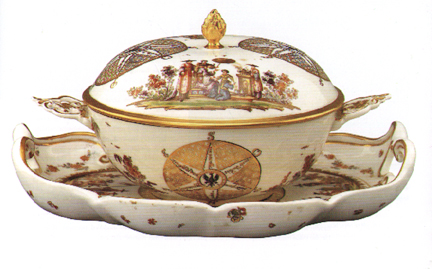It was not until 1709 that the 'arcanum,' or the secret of porcelain manufacture was deduced in Europe. The 'discovery' is credited to Johann Böttger, a German chemist, and scientist Walter Tschirnhausen. Böttger was alchemist to Augustus the Strong of Saxony, an avid collector of Chinese porcelain, who had practically bankrupted the treasury paying for his collection. Eager to not only eliminate this drain on his fortune, but also wanting to capitalize on the eventual sale in Europe of locally produced porcelain, Augustus funded this search. Böttger, while also working on a way to turn base metals into gold, did at least apply the scientific method to his experiments, keeping elaborate notes, and testing combination after combination of ingredients, in an effort to find the right proportions necessary to produce a clay body plastic enough to form, yet vitreous enough to withstand the rigors of a high temperature firing. His discovery led to the establishment of the Meissen porcelain factory, near Dresden in 1710. Most of the early production found its way into Augustus' personal collection, but by 1713 Augustus was forced to start selling the output to raise funds for his military pursuits.
By 1720, Böttger had been succeeded by Johann Höroldt as technical director, and he improved the overglazing process and the palette of colors expanded (see later image). Meissen soon became known as the producer of the highest quality porcelain in Europe and its tablewares graced the tables of Europe's wealthy classes. Early pieces, such as this broth bowl were heavily influenced by Asian styles as the scene atop the lid of this piece attests. These pieces oddly combine Asian and European elements, often juxtaposing them for no apparent design reason. The knob for example is a purely European form, as are the scrolled handles on the bowl and plate. In addition to overglaze decoration, porcelain from Meissen was often lustered with gold, as seen in this example. Meissen was the first European production facility to make hard paste porcelain (fired above 2300° F) and its whiteness and hardness was much admired. Hard paste porcelain is called true porcelain, and is the technical and chemical equivalent of Chinese porcelain in its translucency.

Broth Bowl, Meissen Porcelain with Overglaze Enamel and Luster,
Saxony, Germany, 1735 CE


